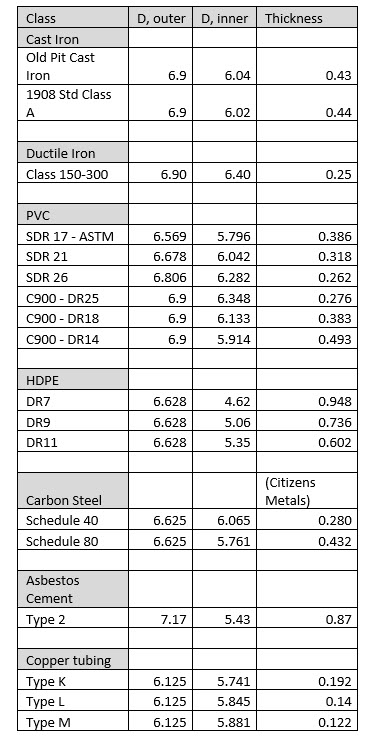Virtuosity Blog
How Big is a 6-inch Pipe?
At first, that sounds like an easy question. Six inches, right? Sort of. But are you talking about the inner diameter (ID), the outer diameter (OD), or the nominal diameter (DN in many countries)? That depends on how you are going to use that information. For hydraulic calculations, you should use the inner diameter. You need the outer diameter for pipe installation, while for sales catalogs, GIS/CAD, and most other purposes, the nominal diameter is simpler.
Most hydraulic modelers use the nominal diameter as the inner diameter, and, in most cases, the inaccuracy that results is not too bad. However, there are differences based on the pipe material, pressure class, and other considerations, which in some cases can be significant.
I’ve compiled some data on pipe internal diameter for 6-inch pipes and summarized it in the table below. The sources are of different quality (AWWA Standards, manufacturer literature, extrapolation) so before you make any design decisions based on this data, confirm the numbers.
The key differentiator for pipe sizing is wall thickness which is determined by the material strength and pressure rating, and comparisons are not necessarily equivalent. Most early pipes were cast iron, and the most important parameter in installing pipe is the OD. The standard OD for old cast iron is 6.90 inches for a nominal 6-inch pipe. New materials such as ductile iron and C-900 PVC honor that OD value, so the ID is simply
ID = OD – 2 t
Where t = thickness
An indicator of wall thickness is the dimension ratio (DR) which is
DR = OD/t
A low value of DR corresponds to a thick-walled pipe and less carrying capacity for the same size pipe.
Some pipes are categorized by their pressure class (usually max pressure + waterhammer allowance) which others are categorized by their thickness class. Each manufacturer provides methods for selecting the correct class of pipe. Apples-to-apples comparisons are tricky. Talking with the sales rep or professional organization (DIPRA for iron pipes; Uni-Bell for PVC pipe) for each material will give you an argument for why their pipe is best. However, be skeptical because I’ve seen misleading claims made by some of these sources.

The ductile iron pipe provides the most carrying capacity for a given nominal size pipe because of its smaller wall thickness due to the material’s greater strength. HDPE (high-density polyethylene) pipe is the exception in that in addition to needing a thick wall, and it sets the OD equal to the nominal diameter. This can result in a significant reduction in capacity when compared with other materials. For example, a 24-inch, thick walled (DR7) HDPE pipe has an ID of 17 inches. That’s 30% less capacity than a nominal 24-inch pipe.
Various types of concrete pipe are the exception to this table in that such pipe is essentially designer pipe where the pressure class depends much more on the prestressing wire rather than the thickness of the concrete, which is really there to prevent the pipe from being crushed. For such pipe, the nominal diameter is close to the ID.
What impact do these differences in pipe diameters have in your model? In hydraulic calculations, the velocity, travel time, and head loss will decrease as the model diameter increases.
So, buying pipe is a lot like buying a “2x4”, which is actually 1.5 inches by 3.5 inches. It’s up to you as the engineer to decide which value you want to use for pipe diameter.
If you want to look up past blogs, go to https://blog.virtuosity.com/tag/water-and-wastewater. And if you want to contact me (Tom), you can email tom.walski@bentley.com.
Want to learn more from our resident water and wastewater expert? Join the Dr. Tom Walski Newsletter today!

